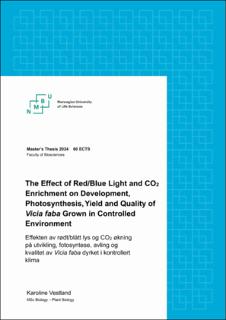| dc.description.abstract | There is a need to explore new methods of food production as effects of climate change influence yield and quality of crops in field production. Higher frequency of extreme weather, new diseases and insect pests, in addition to increased expenses of production are all arguments for examining production in controlled environment. Efficient photosynthesis by CO2 enrichment, LED-lighting and solutions for climate control give the potential to attain more predictable and higher yields, while securing quality of produce. There is also an increased interest in improving national protein production, to limit the dependability on import. With that in mind, two cultivars (´Ratio´ and ´Witkiem major´) of faba beans (Vicia faba) were grown in 3-liter pots in growth chambers given 16 hour photoperiod with 22°C, and 8 hour dark period with 16°C, with between 200-300 mmol/m2/s under high red (R)/blue light (BL) (4:1) or low R/BL (1:1) and with a[CO2](ambient level, approx. 415ppm) or e[CO2](elevated level, approx. 1000ppm).
The results show potential for production of faba beans as a vegetable in controlled environment, as it will benefit from reduction in fungal diseases, especially chocolate spot (Botrytis fabae), which is a detrimental infection in field production. However, the appearance of the injury leaf edge/tip burn is present, which needs to be further studied. For ´Ratio´ high R/BL with e[CO2] developed the fastest, while ´Witkiem major´ showed the same development for high R/BL with e[CO2] and low R/BL with a[CO2]. High R/BL gave generally higher yield and larger DW compared to low R/BL, the same pattern was seen for e[CO2], which increased biomass and total seed FW compared to a[CO2]. However, for ´Witkiem major´ the protein content of the seeds was significantly lower in the high R/BL (26%) compared to the low R/BL (30%), independent of the CO2 concentration. This study showed the potential for controlled environment production of faba beans. However, it highlights the importance of further breeding and selection of cultivars more suitable for controlled environment, as the genetic variance and the differences between cultivars is substantial. | |
